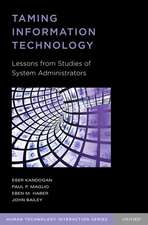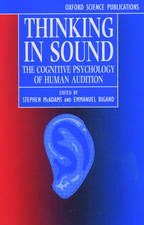Orienting of Attention
Autor Richard D. Wright, Lawrence M. Warden Limba Engleză Hardback – 17 apr 2008
Preț: 353.00 lei
Preț vechi: 430.54 lei
-18% Nou
Puncte Express: 530
Preț estimativ în valută:
67.55€ • 69.69$ • 56.37£
67.55€ • 69.69$ • 56.37£
Carte tipărită la comandă
Livrare economică 15-21 martie
Preluare comenzi: 021 569.72.76
Specificații
ISBN-13: 9780195130492
ISBN-10: 0195130499
Pagini: 304
Ilustrații: 180 black & white illustrations
Dimensiuni: 160 x 236 x 20 mm
Greutate: 0.54 kg
Editura: Oxford University Press
Colecția OUP USA
Locul publicării:New York, United States
ISBN-10: 0195130499
Pagini: 304
Ilustrații: 180 black & white illustrations
Dimensiuni: 160 x 236 x 20 mm
Greutate: 0.54 kg
Editura: Oxford University Press
Colecția OUP USA
Locul publicării:New York, United States
Recenzii
I very much enjoyed reading this excellent and timely book on orienting of attention. After just over 100 years of scientific research on this theme, it offers a comprehensive and up-to-date summary - indeed, a synthesis - of what we currently know, and do not yet know, about visuo-spatial attention. To my mind, this is the only book to provide such a systematic, methodologically and conceptually coherent survey - from a multi-disciplinary perspective - of this exciting field of investigation. Clearly, a lot of thought has gone into the writing - and the outcome is a truly excellent treatise. In summary, I felt both intellectually enriched and inspired by this excellently presented and insightful book - which will come to be seen as a milestone in the field.
Orienting of Attention is a very good book. It represents an impressive, nearly encyclopedic survey of attention shifts, their relation to the underlying brain anatomy and to the eye movement system. This book also documents the important effort to model attention shifts. Although the field of attention shifts is somewhat narrow, it is also one of the most active in neurobiology and cognitive neuroscience. The authors have developed a book that provides a background that is very important for these areas, and particularly for relating models and neurobiological findings to cognitive research. Reading this volume may also be useful even to many who may only have a slight interest in shifts of attention, but hope that the integration of methods and results obtained may be of use in other areas of attention and indeed in psychology as a whole.
Orienting of Attention is a very good book. It represents an impressive, nearly encyclopedic survey of attention shifts, their relation to the underlying brain anatomy and to the eye movement system. This book also documents the important effort to model attention shifts. Although the field of attention shifts is somewhat narrow, it is also one of the most active in neurobiology and cognitive neuroscience. The authors have developed a book that provides a background that is very important for these areas, and particularly for relating models and neurobiological findings to cognitive research. Reading this volume may also be useful even to many who may only have a slight interest in shifts of attention, but hope that the integration of methods and results obtained may be of use in other areas of attention and indeed in psychology as a whole.













